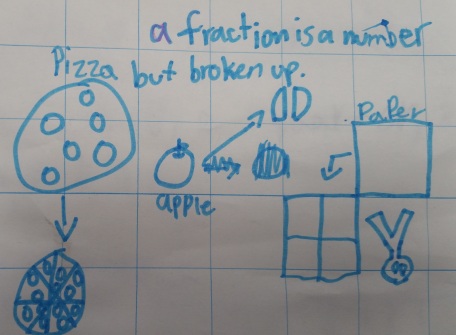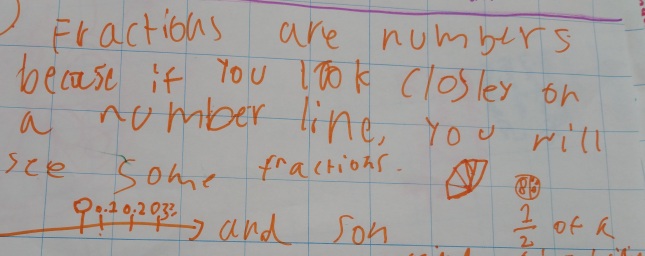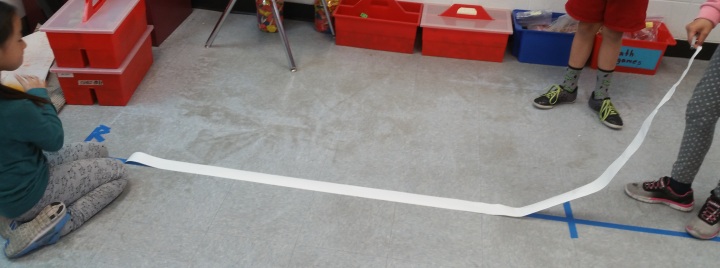This post was supposed to happen after the school year was over. At the end of the year, we spent the last 3 weeks talking about fractions, my favorite topic in grade 3 curriculum. I knew I needed something to keep me going in June. Then the summer started. My memories are hazy now, but I’ll give it a try. Here are the highlights in (to my best recollection) chronological order.
The Cookie Fiasco
The Cookie Fiasco is a wonderful funny book in which four friends are trying to share three cookies. We read the first half, stopped and I asked my students to help the friends with the cookies. Apparently, they could get 1/2 and 1/4 or 3/4. Some students noticed that these must be the same. I noticed that while everyone was successful helping the friends, some students were calling any equal parts halves.
All About Fractions
After my students agreed that the friends had to use fractions to share their cookies fairly, I asked them to tell me all they know about fractions.






Some students also added their wonders.
We spent some time working on notation afterwards. And I asked my students to brainstorm what numbers are to see if fractions fit in. I don’t think everyone was convinced though. Yes, you can count them and they fit on the number line. But they are smaller than numbers. I am still unsure how I should have continued the conversation about fraction being numbers, or parts of numbers, or some new weird numberland creatures.
Number Talks Images and WODB
This image from Number Talks Images website appeared to be a great prompt, intriguing and accessible. My favorite solution: put all halves together, cut one corner watermelon into three quarters, and give these quarters to the other watermelons.

Which One Does Not Belong helped to focus once again on the idea that the same fraction of the same whole can have different shapes.

Half of a Square
I love the paper folding challenge from youcubed website, and we did it this year again. I simplified it a bit. I asked my students to make a triangle that is half of the original square, a quarter of it, then make a square that is a half and prove it to their classmates and to me. “These 2 squares fit on top of each other, they are the same.” I tried to talk about Plato but the audience didn’t seem excited.

The Sad Bunny Story
Once upon a time there lived a lazy bunny who went to visit his friend owl. They had a sleepover, and in the morning lazy bunny was very lazy to go home. The owl suggested that the bunny shouldn’t push himself too hard. He should go half the way on the first day, half of the remaining way on the second day, then half of the remaining way again. How many days will it take for the bunny to make it home?
I don’t remember where I got this story but the scenario worked well for eight-year-olds. We modeled the first couple of days on the clothesline and did the initial estimation.

I offered meter sticks, strips of paper, poster paper, and then in a stroke of insight I taped a couple of number lines on the floor. We ended up getting together and doing a proving part on the large number line. “Three days? Can you show me on this line?”




My stories about Zeno were met with much more enthusiasm. Especially the Arrow paradox. My students did a bit of experimenting with throwing non-sharp objects to prove to me that they do indeed hit the target. “The Paradox!”
Clothesline Fractions
Building on our work with the fractions on the number line, I asked my students to put these fractions in order in their table groups, and then we discussed the order and found a correct place for each one. One half and two quarters caused a debate. “Can you have two numbers at the same place on a number line? Is it the same number or different?”

Quarter the Cross
I was really excited to try this challenge in my classroom. For the first lesson, I followed the lesson outline that David Butler described in his blog. I gave out the templates with the crosses, my students sketched down some ideas, did the gallery walk, shared a few with the class, and then everyone had another try.
I’ve decided to end the year with the quick art project. Quarter the cross. Same fraction. Different shape. Two colors.

Questions and Thoughts
I wonder at which point fractions stop being a wonderful new mathematical concept and start being frustrating and challenging. Is it when students need to start adding, subtracting, multiplying and dividing them? Is there anything I can do to prepare them for this? What intuitions would be helpful?


















I have a few suggestions……
1. Multiplication is action and so the basic aim is to apply an action, say three times, to a statement, say 4. The result is “three lots of four things each”, or “three times a lot of four”.
The expression “3 x 4” is otherwise meaningless.
2. The word “of” in fraction expressions is a special word, as it is limited to explicit fraction speak. Compare “half of three” and “two and a half times three”.
3. I am looking to words and meaning until eventually the formal cryptic version will appear.
4. I love the pictures!
5. So multiplication first, division second, and addition/subtraction LAST.
LikeLiked by 1 person
Interesting thought. In grade 4 students learn about fractions of the set, which is kind of a fraction multiplied by a whole number. I find a challenge with teaching fractions of a set is that it reinforces an idea that fractions are not numbers but parts of other numbers. I can see a number string like. 8 x 1, 8 x 4, 8 x 10, 8 x 1/2. I touched on division briefly (could not resist). 6÷2 – How many times does 2 fit into 6? 6÷1/2 – How many times 1/2 fit into 6?
LikeLike
I’d go with this too. I think part of the reason they think “half can go lots of differnet places” is because we can take half of anything, and we can be halfway between anything. The “half” that comes between 0 and 1 is the same size as the “half” between 113 and 114.
LikeLike
WOW! Quarter the cross is often impressive, but these are spectacular.
Your question at the end is huge. This goes a long way towards making it better, I think. They’ve explored fractions as quantities and compared them as values. Next for me would be operations in a context where fractions make sense as amounts.
LikeLike
Thank you, John! I was very excited about our quarter the cross! Not a single student out of 50 stuck with the easiest solution. Everyone tried to make some new and challenging ones. I will certainly do it again with gr5 next year. Amie Albrecht had a fun idea: students can compare different solutions and see how they can cut and re-arrange theirs to make their partner’s design.
Alberta curriculum takes it very slowly with fractions. There are formally no operations with fractions introduced until gr7 which doesn’t mean I am not going to do it when I see fit. I’d like students to start getting comfortable with operations. Maybe numberless word problems? Next year I need to cover equivalent fractions and comparing fractions with different denominators. I planned lots of geometry connections, but I might need to look for some story context as well!
LikeLike
Its a bit cryptic, but does a lot. Check out the fractions and geometry:
https://howardat58.wordpress.com/2017/04/29/geometry-and-numbers-not-the-counting-sort/
LikeLike
I think it’s great how you swept through fractions in lots of ways -stories, geometry… paradox. I too really like your Quarter the Crosses, and how the kids made such bold choices – well worth the art connection!
I had to look back at my fractions work with grade 3 , you know it I think: http://followinglearning.blogspot.fr/2016/05/fractions-and-someone-help-me-out-with.html
I think it’s good that you don’t officially have to press on with fractions in equations – not that it can’t be done, just that that my guess is that this much love is usually lavished on fractions pure and simple. (I don’t think that fractions of sets takes away from their number-ness; saying half of
30 is not so different to saying 3 thirties.)
LikeLike
That should say *isn’t* usually lavished.
LikeLike
I remember this blog post of yours now! Last time I read it I got distracted by trying to figure out what my theory of learning is (still working on this one). Something that you have done extensively in your fractions lessons is allowing students to build and explore with Cuisenaire rods. I gave my students some fraction puzzles to solve with color tiles and pattern blocks, but I feel this year I will aim for more hands on experiences. I like Ford Circles too. The size of the circles threw me off, so I know it will be a good discussion generator + connection to decimals. Fractions and negative numbers were prime sources of curiosity for my students this year, I hope my grade 5s will find them just as fascinating.
LikeLike
There is a mathematical/philosophical problem in “numbers”. We, the in-the-know ones just switch from whole numbers (counting numbers) to fractional numbers (measurement numbers) and back with no thought required. Kids have been drilled on counting numbers till the cows come home, and then meet “fractions”, which they find mysterious, especially when seeing 3 and 3/1 and being told that they are “the same”. It would be much more useful to consider measurements and then fractional numbers as a natural development.It will finally appear that “3” can be used as a short version of”3/1″ in measurement numbers.
LikeLiked by 1 person
I think that’s where the number line model comes really handy. And if students are already used to modeling operations and relationships on the number line, making sense of fractions might be not as frightening.
I noticed an interesting thing. Every year when I ask students to put 1/2 on the number line the first time, they consistently agree that it can be between any two numbers. I guess it’s a sign of this “whole number” thinking. You can split anything in half but there is only one spot on the number line where the half belongs…that’s some tough news to process.
LikeLike
They will probably have seen number lines with just the “half” marked between the bigger numbers, too.
47 and a half is 47 + one half… and that half is the same size as the one in the “right” place on the number line…
LikeLike